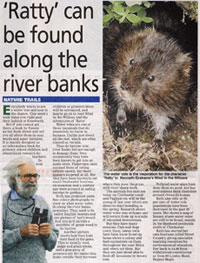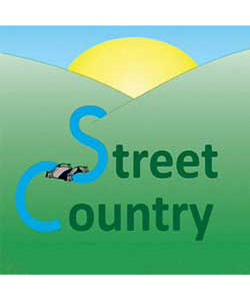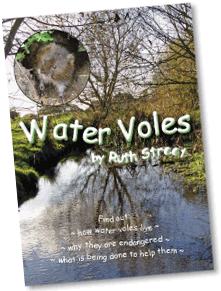‘Ratty’ can be found along the river banks by RICHARD WILLIAMSON
 Published on Thursday 1st March 2012
Published on Thursday 1st March 2012
Everybody wants to see a water vole and now is the chance. This week’s walk takes you right past their habitat at Emsworth.
But if you cannot get there, a book by Sussex writer Ruth Street will tell you all about them in easy words and super pictures. It is mainly designed as an information book for primary school children and educational resource for teachers.
So your children or grandchildren will be entranced, and maybe go on to read Wind in the Willows and the adventures of ‘Ratty’.
Water voles are one of those mammals that do absolutely no harm to humans. Unlike just about all the rest, which are often classed as vermin.
They do burrow into river banks but not enough to damage them. Very occasionally they have been known to get into an apple store. Fishermen once accused them of eating salmon spawn, but there appears no proof at all. But they have been known to eat small freshwater bivalves on occasion, and a century ago were accused of eating turnips in gardens.
Ruth has produced some fine colour photographs to show us what water voles do along the river banks nowadays. They used to be called English beavers and one picture of her’s would fool you as it carries a mouthful of green weed to its burrow.
Another picture shows how they hold their food in the paws. This is usually reed, sedge and grass stems, and a give-away of presence are the lawns they make outside their burrows where they mow the grass with their sharp teeth.
The animals you may see today on Chichester canal and Pagham too will be the young of last year which are about to start breeding in the spring. Research shows water voles stay at home and will return from up to a mile if relocated downstream.
But they have many enemies. Cats and dogs catch them, tawny owls have been know to set up home above a colony and feed exclusively on them throughout the year. Mink and otters eat them. But they are just about able to fend off invasions by brown rats.
Polluted water ways have done them no good, nor has over-zealous bank clearance around riverside homes.
Ruth also tells us 90 per cent of water vole populations have been destroyed in the past 30 years. She shows a map of Sussex where water voles are still to be found, mainly in the Manhood peninsula south of Chichester.
Ruth has started her own business called Street Country, giving specialist teaching resources for environmental education.
Her book is £4.99 from This email address is being protected from spambots. You need JavaScript enabled to view it.


















